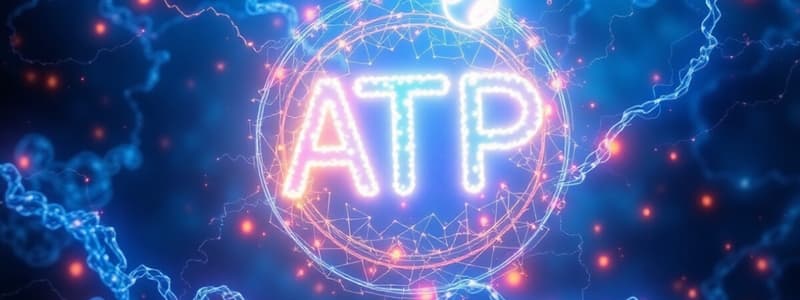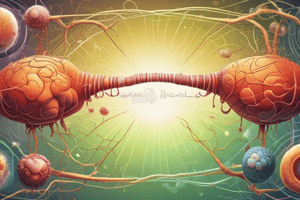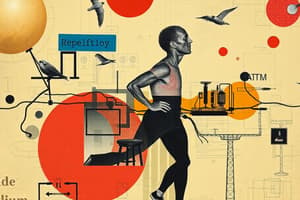Podcast
Questions and Answers
What is the primary function of Rubisco in the Calvin Cycle?
What is the primary function of Rubisco in the Calvin Cycle?
- To attach CO2 to ribulose bisphosphate (correct)
- To produce G3P
- To generate ATP
- To release oxygen
The Calvin cycle is dependent on light.
The Calvin cycle is dependent on light.
False (B)
What is G3P and its significance in the Calvin Cycle?
What is G3P and its significance in the Calvin Cycle?
G3P is a three-carbon sugar produced in the Calvin Cycle, used to synthesize other sugars and organic molecules.
The process of incorporating CO2 into organic materials is known as __________.
The process of incorporating CO2 into organic materials is known as __________.
Match the following terms with their descriptions:
Match the following terms with their descriptions:
During the light-dependent reactions, what products are generated?
During the light-dependent reactions, what products are generated?
Oxygen is a byproduct of the Calvin Cycle.
Oxygen is a byproduct of the Calvin Cycle.
Name two products generated by the Calvin Cycle.
Name two products generated by the Calvin Cycle.
What is the role of Rubisco in photosynthesis?
What is the role of Rubisco in photosynthesis?
Rubisco is the least abundant enzyme on Earth.
Rubisco is the least abundant enzyme on Earth.
What is the initial product of carbon fixation in the Calvin Cycle?
What is the initial product of carbon fixation in the Calvin Cycle?
The major products of cellular respiration include carbon dioxide (CO2), water (H2O), and ___.
The major products of cellular respiration include carbon dioxide (CO2), water (H2O), and ___.
Which of the following is NOT a stage of cellular respiration?
Which of the following is NOT a stage of cellular respiration?
Match the following processes with their main function:
Match the following processes with their main function:
Anaerobic fermentation produces ATP but does not regenerate NAD+.
Anaerobic fermentation produces ATP but does not regenerate NAD+.
What does lactic acid fermentation convert pyruvic acid into?
What does lactic acid fermentation convert pyruvic acid into?
What is the primary energy currency of the cell?
What is the primary energy currency of the cell?
ADP is generated during exergonic reactions.
ADP is generated during exergonic reactions.
What process combines ADP with a phosphate molecule to form ATP?
What process combines ADP with a phosphate molecule to form ATP?
The process by which organisms use oxygen to turn fuel into chemical energy is called _______.
The process by which organisms use oxygen to turn fuel into chemical energy is called _______.
Which statement best describes anaerobic respiration?
Which statement best describes anaerobic respiration?
During the ATP-ADP cycle, ATP is constantly converted into ADP and back again.
During the ATP-ADP cycle, ATP is constantly converted into ADP and back again.
What type of reactions does chlorophyll participate in during photosynthesis?
What type of reactions does chlorophyll participate in during photosynthesis?
Flashcards
Calvin Cycle
Calvin Cycle
The light-independent stage of photosynthesis, converting CO2 into sugars using ATP and NADPH.
Carbon Fixation
Carbon Fixation
The process of incorporating CO2 into an organic molecule (e.g., sugar).
RuBisCo
RuBisCo
Enzyme attaching CO2 to a 5-carbon sugar in the Calvin Cycle.
G3P
G3P
Signup and view all the flashcards
Light-independent reactions
Light-independent reactions
Signup and view all the flashcards
NADPH role
NADPH role
Signup and view all the flashcards
ATP Role
ATP Role
Signup and view all the flashcards
ADP and NADP+
ADP and NADP+
Signup and view all the flashcards
Exergonic vs. Endergonic
Exergonic vs. Endergonic
Signup and view all the flashcards
ATP-ADP Cycle
ATP-ADP Cycle
Signup and view all the flashcards
Cellular Respiration
Cellular Respiration
Signup and view all the flashcards
Anaerobic Respiration
Anaerobic Respiration
Signup and view all the flashcards
Phosphorylation
Phosphorylation
Signup and view all the flashcards
Activation Energy
Activation Energy
Signup and view all the flashcards
Photosynthesis: Light-Dependent Reactions
Photosynthesis: Light-Dependent Reactions
Signup and view all the flashcards
Rubisco's Dual Role
Rubisco's Dual Role
Signup and view all the flashcards
Product of Carbon Fixation
Product of Carbon Fixation
Signup and view all the flashcards
Cellular Respiration Goal
Cellular Respiration Goal
Signup and view all the flashcards
Autotrophs and Heterotrophs
Autotrophs and Heterotrophs
Signup and view all the flashcards
Photosynthesis and Respiration Interdependence
Photosynthesis and Respiration Interdependence
Signup and view all the flashcards
Energy Released in Breakdown
Energy Released in Breakdown
Signup and view all the flashcards
Stages of Cellular Respiration
Stages of Cellular Respiration
Signup and view all the flashcards
Glycolysis Overview
Glycolysis Overview
Signup and view all the flashcards
Study Notes
ATP and Energy Metabolism
- ATP (adenosine triphosphate) is the primary energy currency of cells, providing energy for various cellular processes.
- ATP is composed of adenine, a five-carbon sugar (ribose), and three phosphate groups.
- ATP plays a crucial role in linking exergonic (energy-releasing) and endergonic (energy-requiring) reactions, allowing energy transfer between them.
- During exergonic reactions, ATP is generated; during endergonic reactions, ATP is broken down to ADP (adenosine diphosphate).
- ADP is the primary recipient of energy from ATP breakdown, allowing for recycling back into ATP.
- The primary role of ADP is to accept energy from ATP breakdown to drive endergonic reactions.
Cellular Respiration and Energy Production
- The primary energy source for living organisms is the breakdown of glucose and other nutrients via cellular respiration.
- Cellular respiration is the process where organisms use oxygen to convert fuel into chemical energy, producing ATP as a byproduct.
- Anaerobic respiration is a type of respiration that generates energy in the absence of oxygen by breaking down sugars.
- The energy required for reactions not releasing energy is called activation energy.
ATP Synthesis and Phosphorylation
- ATP synthesis involves combining ADP with a phosphate molecule, a process called phosphorylation.
- The energy released from breaking a molecular bond in ATP comes from the energy stored in phosphate bonds.
- ATP is the premier energy molecule in living cells, powering various cellular processes.
The ATP-ADP Cycle
- The ATP-ADP cycle describes the continuous conversion of ATP to ADP and back again.
- ATP releases energy when a phosphate group is removed, converting it to ADP.
- The released energy powers cellular processes.
- ADP can be re-phosphorylated to ATP using energy from various sources like cellular respiration or photosynthesis.
Photosynthesis: Light-Dependent Reactions
- Chlorophyll and other pigments absorb light energy.
- Absorbed energy excites electrons in the pigments.
- Excited electrons move through an electron transport chain, generating ATP and NADPH.
- Water is split, releasing oxygen as a byproduct.
Photosynthesis: Products of the Light-Dependent Reactions
- ATP is a primary energy carrier used in the Calvin Cycle.
- NADPH is a reducing agent used in the Calvin Cycle.
- Oxygen is a byproduct released into the atmosphere.
The Calvin Cycle
- The Calvin cycle is the light-independent stage of photosynthesis.
- The cycle uses energy from ATP and NADPH's reducing power to convert carbon dioxide into sugar.
- Melvin Calvin and his team at the University of California, Berkeley, discovered the Calvin cycle.
- The Calvin cycle is also known as the Calvin-Benson cycle or the C3 cycle.
- The cycle is the main process by which plants fix carbon dioxide into organic compounds, specifically glucose.
G3P (Glyceraldehyde 3-phosphate)
- G3P is a three-carbon sugar produced in the Calvin Cycle.
- G3P is used to synthesize other sugars and organic molecules.
Carbon Fixation
- Carbon fixation is the process of incorporating CO2 into an organic material.
RuBisCo
- RuBisCo (ribulose-1,5-bisphosphate carboxylase/oxygenase) is an enzyme responsible for attaching CO2 to a five-carbon sugar molecule, ribulose bisphosphate, in the Calvin Cycle.
Six-Carbon Sugar: Fate after Carbon Fixation
- The resulting six-carbon sugar is unstable and quickly breaks down into two molecules of 3-phosphoglycerate (3-PGA).
NADPH Role in the Calvin Cycle
- NADPH provides electrons to reduce 3-PGA into G3P, used in glucose and other organic molecule synthesis.
G3P Fate: The Calvin Cycle
- Most G3P molecules regenerate the five-carbon sugar (ribulose bisphosphate) to continue the cycle.
- A portion of G3P is used to create glucose and other organic molecules, vital for plant growth and energy storage.
ADP and NADP+ Fate after the Calvin Cycle
- ADP and NADP+ formed during the Calvin Cycle return to the light-dependent reactions to be re-energized, ensuring sufficient energy carrier supply.
Rubisco Function
- Rubisco is the most abundant enzyme on Earth, crucial for the Calvin Cycle.
- Rubisco has a dual role in fixing CO2 and oxygen.
- Rubisco's affinity for oxygen can limit plant growth.
Product of Carbon Fixation
- The initial product of carbon fixation is an unstable six-carbon sugar, which breaks down into two molecules of 3-phosphoglycerate (3-PGA).
Cellular Respiration Overview
- Cellular respiration produces ATP by breaking down organic compounds.
- Both autotrophs and heterotrophs utilize cellular respiration.
Photosynthesis Relationship
- Photosynthesis converts light energy to chemical energy in autotrophs.
- Products of photosynthesis serve as reactants in cellular respiration, highlighting their interdependence.
Breakdown of Organic Compounds
- The breakdown of organic compounds releases energy, primarily used to produce ATP.
Stages of Cellular Respiration
Cellular respiration involves glycolysis, the Krebs cycle, and the electron transport chain.
- Glycolysis converts glucose to pyruvic acid, yielding ATP and NADH.
- The Krebs cycle breaks down acetyl CoA, producing ATP, CO2, and electron carriers.
- The electron transport chain generates ATP via an electron transport pathway.
Glycolysis Steps
- In glycolysis, glucose is phosphorylated into glucose-6-phosphate, split into two 3-carbon molecules (G3P), and then G3P loses electrons, transforming NAD+ into NADH.
- Phosphates are removed, generating pyruvic acid and producing ATP from ADP.
Anaerobic vs. Aerobic Conditions
- In the absence of oxygen, pyruvic acid undergoes fermentation – a process that regenerates NAD+.
- In the presence of oxygen, pyruvic acid enters aerobic respiration.
Fermentation Types
- Lactic acid fermentation converts pyruvic acid to lactic acid (e.g., in muscle cells during strenuous exercise).
- Alcoholic fermentation converts pyruvic acid to ethyl alcohol and releases CO2 (e.g., in plant cells and unicellular organisms).
Krebs Cycle and Electron Transport Chain
- Aerobic respiration involves the Krebs cycle and the electron transport chain (ETC).
- The Krebs cycle breaks down acetyl CoA, releasing CO2, hydrogen atoms, and ATP.
- The electron transport chain utilizes oxygen as the final electron acceptor, generating significant ATP.
Final Electron Acceptors and Energy Yield
- The final electron acceptor in the ETC is oxygen.
- Aerobic respiration generates significantly more ATP than glycolysis.
Energy Efficiency
- Glycolysis efficiency is measured by the energy needed to create ATP over glucose oxidation energy.
- The overall cellular respiration efficiency shows how effectively glucose is converted to usable energy.
Phases of Cellular Respiration
- Glycolysis, the Krebs cycle, and the electron transport chain are the three main phases of cellular respiration.
Location of Processes
- Glycolysis occurs in the cytoplasm.
- The Krebs cycle takes place in the mitochondrial matrix.
- The electron transport chain is in the inner mitochondrial membrane.
ATP Production
- Glycolysis yields a net gain of 2 ATP.
- The Krebs Cycle generates 2 ATP.
- The electron transport chain produces up to 34 ATP.
Byproducts of Cellular Respiration
- Carbon dioxide is a byproduct of the Krebs cycle.
- Water is a byproduct of the electron transport chain.
Substrates in Cellular Respiration
- Glucose is a substrate for glycolysis.
- Oxygen is a substrate for the electron transport chain.
NADH and FADH2
- Each NADH molecule can produce about 3 ATP in the electron transport chain.
- Each FADH2 molecule yields approximately 2 ATP.
Enzyme Deficiency Impact
- Missing or defective enzymes at any step can halt cellular respiration beyond that point.
Anaerobic Conditions
- In the absence of oxygen, pyruvic acid accepts high-energy electrons from NADH.
Fermentation Reactions
- Yeast fermentation produces ethanol, CO2, 2 ATP, and heat from glucose.
- Lactic acid fermentation produces lactate, 2 ATP, and heat from glucose.
Studying That Suits You
Use AI to generate personalized quizzes and flashcards to suit your learning preferences.




